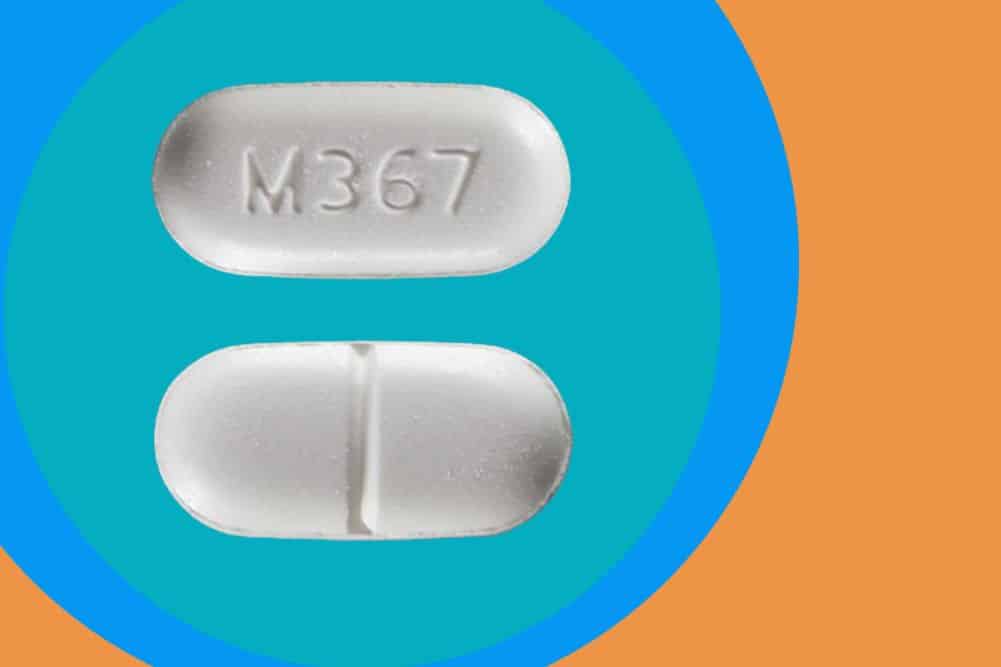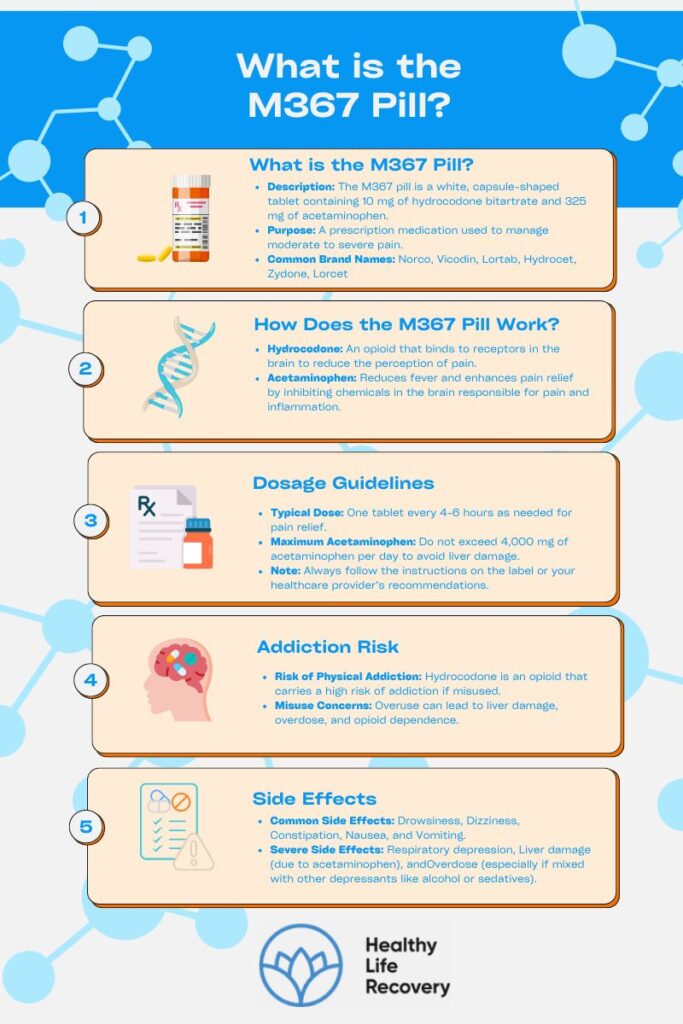The M367 pill is a prescription medication used to manage moderate to severe pain. This white, oval-shaped tablet contains a combination of two active ingredients: 10 mg of hydrocodone bitartrate and 325 mg of acetaminophen. Hydrocodone is an opioid pain reliever, while acetaminophen is a non-opioid painkiller and fever reducer. When combined, these two ingredients provide effective pain relief, often prescribed after surgeries, injuries, or for chronic pain management.
Composition of M367
The M367 pill is a combination medication designed to offer effective pain relief by leveraging two powerful ingredients: hydrocodone bitartrate and acetaminophen. Each component plays a unique role in pain management, working together to alleviate moderate to severe pain. Understanding the composition of the M367 pill is essential for recognizing its benefits, risks, and potential side effects.
- Hydrocodone Bitartrate (10 mg): Hydrocodone is a semi-synthetic opioid that works by binding to opioid receptors in the brain and spinal cord. This blocks the pain signals, altering how the body perceives pain. It is effective in treating moderate to severe pain but also comes with a high risk of dependence, addiction, and misuse.
- Acetaminophen (325 mg): Also known as paracetamol, acetaminophen is a commonly used pain reliever and fever reducer. It works by inhibiting specific enzymes in the brain responsible for pain and fever. While safe at prescribed doses, excessive intake can lead to liver damage.
Identifying M367 Pill
The M367 pill is easy to identify. It is white, oblong-shaped, and has the imprint “M367” on one side with a bisecting line on the other. This line allows the pill to be split in half if a smaller dose is needed. However, always consult a healthcare provider before altering the dosage.

Uses of the M367 Pill
The M367 pill is prescribed to manage various types of pain, such as:
- Post-surgical pain
- Injury-related pain
- Chronic pain conditions that require more potent relief than over-the-counter medications can provide
Due to the presence of hydrocodone, it is typically used when other, less powerful pain relievers fail to offer adequate relief.
Brand Names and Street Names for M367 Pills
The M367 pill, which contains a combination of hydrocodone and acetaminophen, is commonly known by several brand names and street names. Recognizing these names can help individuals identify the medication and be aware of its potential for misuse or abuse.
Brand Names
M367 pills are a generic form of the medication, but the same combination of hydrocodone and acetaminophen is available under various well-known brand names. Some of the most common include:
- Norco: A widely prescribed brand that combines different strengths of hydrocodone and acetaminophen.
- Vicodin: Perhaps the most recognized name, Vicodin has long been used to manage moderate to severe pain.
- Lortab: Another popular brand that blends hydrocodone with acetaminophen to relieve pain and reduce fever.
- Hydrocet: A brand often prescribed for post-surgical or injury-related pain relief.
- Lorcet: Known for its combination of hydrocodone and acetaminophen, Lorcet is typically used in cases of significant pain.
- Zydone: A lesser-known brand, but still used for similar pain management purposes.
- Xodol: Another brand that offers the same combination of hydrocodone and acetaminophen in various doses.
These brand names are commonly prescribed by healthcare providers to manage moderate to severe pain. However, all carry the same risks associated with opioid use, including dependence, addiction, and overdose.
Street Names
In addition to its brand names, M367, and other hydrocodone-acetaminophen combination pills are frequently referred to by various street names. These names often emerge in contexts of recreational use or drug misuse, and understanding them is critical for recognizing potential abuse. Common street names for hydrocodone-based pills include:
- Vikes: Derived from Vicodin, one of the most popular brands, this term is commonly used to refer to hydrocodone pills.
- Hydros: A shorthand name for hydrocodone, frequently used in the context of recreational opioid use.
- Tabs: Refers to the tablet form of hydrocodone medications, often used informally.
- Loris: A nickname based on the brand name Lortab.
- Watsons: Named after Watson Pharmaceuticals, a manufacturer of generic hydrocodone-acetaminophen tablets.
- 367s: Specifically refers to M367 pills, using their imprint code.
- Happy Pills: This nickname alludes to the euphoric feeling hydrocodone can induce when misused.
Understanding these street names is crucial in identifying misuse or illegal distribution. Individuals using these terms may be referring to non-prescribed or recreational use, which significantly increases the risk of addiction, overdose, and other serious health complications.
Dangers of Street Use
Street use of hydrocodone-based medications like M367 is particularly dangerous due to the risk of obtaining counterfeit pills. These counterfeit pills may be laced with dangerous substances such as fentanyl, a potent synthetic opioid that is far stronger than hydrocodone. Even small amounts of fentanyl can lead to life-threatening overdoses. Because counterfeit pills often appear identical to legitimate ones, the risk of unintentional overdose is heightened when purchasing drugs outside of legal prescriptions.
Moreover, the recreational use of hydrocodone often leads to dependency and addiction, requiring professional treatment to overcome. Anyone who suspects misuse or encounters these street names should seek help or advise the individual to consult a healthcare provider or addiction treatment professional.
Recognizing the various brand and street names for M367 and similar hydrocodone-based medications is an essential step in preventing misuse and understanding the potential risks associated with these powerful painkillers. Always ensure that medications like M367 are taken as prescribed by a healthcare professional to avoid the significant health risks involved in misuse or addiction.
How Does M367 Work?
The M367 pill works by combining two active ingredients, hydrocodone and acetaminophen, to provide potent pain relief. Hydrocodone, an opioid, alters how the brain perceives pain, while acetaminophen reduces pain and fever through a different mechanism. Together, these components enhance each other’s effects, offering a comprehensive approach to managing moderate to severe pain. Understanding how M367 works can help ensure its safe and effective use.
- Hydrocodone: This opioid attaches to specific receptors in the brain, blocking the pain signals from reaching other parts of the body. This not only reduces the sensation of pain but can also produce feelings of euphoria and relaxation.
- Acetaminophen: It enhances the effects of hydrocodone by reducing fever and alleviating pain through a different mechanism. Together, these two ingredients provide a stronger pain-relieving effect.

Side Effects and Risks of M367s
While the M367 pill is effective for managing moderate to severe pain, it also comes with a range of potential side effects, both short-term and long-term, that vary in severity. The presence of hydrocodone, a potent opioid, significantly increases the risk of misuse, dependence, and other serious health complications. Understanding the side effects and risks associated with M367 is essential for using the medication safely and minimizing harm.
Short-Term Side Effects
Taking M367 can result in several common short-term side effects, particularly when the body is adjusting to the medication. These include:
- Drowsiness: Opioids like hydrocodone can cause significant sedation, making it unsafe to operate machinery or drive while taking the medication.
- Dizziness: Many individuals experience dizziness or lightheadedness, especially after the first few doses.
- Nausea and Vomiting: Opioids are well-known for causing nausea, particularly when the medication is first started. This side effect may diminish as the body adapts.
- Constipation: Opioids slow down the digestive system, often leading to constipation, which can persist throughout treatment. Drinking water and increasing fiber intake can help alleviate this discomfort.
- Dry Mouth: A reduction in saliva production is another common side effect, which can cause discomfort or difficulty swallowing.
- Headaches: Some users report mild to moderate headaches, often during the first few days of taking the medication.
These side effects can generally be managed with supportive care, and many diminish over time. However, if they persist or worsen, it’s important to contact a healthcare provider.
Long-Term Side Effects
Prolonged use of M367 can lead to more severe side effects, particularly as the body builds tolerance to the medication. Long-term users should be aware of the following risks:
- Tolerance: Over time, the body may become accustomed to the medication, requiring higher doses to achieve the same level of pain relief. This can increase the risk of overdose and dependence.
- Dependence and Addiction: Hydrocodone is an opioid with a high potential for addiction. Long-term use can lead to physical dependence, where users experience withdrawal symptoms if they try to stop. Psychological dependence, or addiction, can also develop, characterized by compulsive drug-seeking behavior despite harmful consequences.
- Liver Damage: The acetaminophen component of M367 is metabolized in the liver. Chronic or excessive use of acetaminophen, especially in combination with alcohol, can lead to serious liver damage or even liver failure. Individuals with pre-existing liver conditions or those taking other medications affecting liver function are at increased risk.
- Respiratory Depression: Opioids, including hydrocodone, can suppress the respiratory system, leading to slow or shallow breathing. In severe cases, this can cause respiratory failure, a life-threatening condition. This risk increases with higher doses or when M367 is combined with other central nervous system depressants like alcohol or sedatives.
- Hormonal Imbalance: Long-term opioid use can impact the body’s hormonal balance, particularly affecting cortisol levels, which may lead to fatigue, mood swings, or physical weakness.
- Cognitive and Mood Changes: Chronic opioid use can affect mental health, potentially leading to mood swings, depression, anxiety, or irritability. Some users may experience difficulty concentrating or memory issues over time.
Risks of Misuse and Overdose
Because M367 contains hydrocodone, an opioid, it carries a significant risk of misuse and overdose. Overdosing on opioids can lead to:
- Severe Respiratory Depression: An opioid overdose can cause breathing to become dangerously slow or stop altogether, leading to unconsciousness or death if not treated promptly.
- Unconsciousness or Coma: High doses of hydrocodone can depress the central nervous system to the point where the individual becomes unresponsive or slips into a coma.
- Fatal Liver Damage: An overdose of acetaminophen, especially when combined with alcohol or other medications affecting the liver, can lead to acute liver failure, which is potentially fatal if not treated immediately.
Signs of an Overdose:
- Slow, shallow, or labored breathing
- Extreme drowsiness or inability to wake up
- Pinpoint pupils (very small black circles in the eyes)
- Loss of consciousness
- Bluish tint to lips or skin (due to lack of oxygen)
If you suspect someone has overdosed on M367, seek emergency medical help immediately. The opioid reversal medication naloxone can be used to counteract the effects of opioid overdose and can save lives if administered in time.
Potential Drug Interactions with M367 Pills
M367 pills, which contain hydrocodone and acetaminophen, can interact with various other medications, supplements, or substances. These interactions may increase the risk of side effects, reduce the efficacy of the treatment, or lead to serious complications. Understanding potential drug interactions is essential for ensuring the safe use of M367 and avoiding adverse outcomes. Always inform your healthcare provider about all medications you are taking to avoid harmful interactions.
Opioid and Central Nervous System (CNS) Depressants
Hydrocodone, the opioid component of M367, is a central nervous system (CNS) depressant. When combined with other medications that also depress the CNS, the risk of severe side effects, including respiratory depression, sedation, or even coma, is significantly increased. Medications and substances that depress the CNS include:
- Benzodiazepines: Drugs like diazepam (Valium), lorazepam (Ativan), and alprazolam (Xanax), often prescribed for anxiety, insomnia, or seizures, can amplify the sedative effects of hydrocodone. The combination may lead to profound drowsiness, respiratory depression, or coma.
- Other Opioids: Combining M367 with other opioid medications (e.g., oxycodone, morphine, fentanyl) or opioid-containing products can increase the risk of opioid overdose, resulting in severe respiratory depression and death.
- Sedatives and Hypnotics: Medications used to treat insomnia or anxiety, such as zolpidem (Ambien) or eszopiclone (Lunesta), can compound the sedative effects of M367, leading to excessive drowsiness or respiratory depression.
- Alcohol: Drinking alcohol while taking M367 can dangerously enhance the CNS depressant effects of hydrocodone, increasing the risk of overdose, respiratory depression, liver damage (due to acetaminophen), or even death.
- Muscle Relaxants: Medications like cyclobenzaprine (Flexeril) or carisoprodol (Soma) can intensify the sedative effects of M367, making it more likely to experience extreme drowsiness or difficulty breathing.
Antidepressants and Serotonin Syndrome
Some antidepressants, particularly those that affect serotonin levels in the brain, can interact with opioids like hydrocodone, increasing the risk of a potentially life-threatening condition called serotonin syndrome. This occurs when there is an excess of serotonin in the brain, leading to symptoms such as agitation, confusion, rapid heart rate, high blood pressure, muscle rigidity, and seizures. Medications that can increase this risk include:
- Selective Serotonin Reuptake Inhibitors (SSRIs): Drugs like fluoxetine (Prozac), sertraline (Zoloft), or citalopram (Celexa) can increase serotonin levels, which, when combined with opioids, may trigger serotonin syndrome.
- Serotonin-Norepinephrine Reuptake Inhibitors (SNRIs): Medications like duloxetine (Cymbalta) or venlafaxine (Effexor), which increase both serotonin and norepinephrine levels, can similarly lead to serotonin syndrome when combined with M367.
- Monoamine Oxidase Inhibitors (MAOIs): These older antidepressants (e.g., phenelzine (Nardil), tranylcypromine (Parnate)) have significant interactions with opioids. Taking M367 with an MAOI, or within 14 days of discontinuing an MAOI, can lead to dangerously high serotonin levels or other serious interactions.
Medications that Affect Liver Function
Acetaminophen in M367 is metabolized in the liver, and combining it with other medications that impact liver function can increase the risk of liver damage. This is particularly concerning when acetaminophen is taken at higher doses or over prolonged periods. Medications that affect liver enzymes include:
- Antibiotics: Some antibiotics, such as rifampin and isoniazid, can induce liver enzymes, increasing the risk of liver toxicity when taken with acetaminophen.
- Antifungal Medications: Drugs like ketoconazole and fluconazole can inhibit liver enzymes responsible for breaking down acetaminophen, leading to a buildup of the drug and an increased risk of liver damage.
- Antiepileptic Medications: Medications like carbamazepine (Tegretol) and phenytoin (Dilantin) can induce liver enzymes, increasing the rate at which acetaminophen is metabolized and raising the risk of liver toxicity with prolonged use.
- Hepatotoxic Drugs: Other medications known to cause liver damage, such as methotrexate or statins, may increase the risk of liver injury when combined with acetaminophen-containing medications like M367.
Anticholinergic Medications
Medications with anticholinergic effects can worsen certain side effects of hydrocodone, particularly constipation, dry mouth, urinary retention, and confusion. These effects can be particularly troubling for older adults. Common anticholinergic drugs include:
- Antihistamines: Over-the-counter medications like diphenhydramine (Benadryl) or chlorpheniramine can intensify dry mouth, constipation, and sedation.
- Bladder Medications: Drugs like oxybutynin (Ditropan) and tolterodine (Detrol), used to treat overactive bladder, can exacerbate urinary retention and other side effects of M367.
- Tricyclic Antidepressants (TCAs): Medications like amitriptyline and nortriptyline have strong anticholinergic properties and, when combined with M367, may increase the risk of confusion, constipation, or dry mouth.
Medications that Lower Seizure Threshold
Opioids, including hydrocodone, can lower the seizure threshold, making it more likely for someone to experience seizures. This risk is elevated when M367 is combined with other medications that also lower the seizure threshold. These include:
- Antidepressants: Certain antidepressants, particularly bupropion (Wellbutrin), can increase the risk of seizures when taken with opioids.
- Antipsychotic Medications: Drugs like clozapine (Clozaril) or chlorpromazine can increase the likelihood of seizures when taken with M367.
- Stimulants: Medications like amphetamine (Adderall) or methylphenidate (Ritalin), commonly used to treat ADHD, can also lower the seizure threshold when taken with hydrocodone.
Blood Thinners and Acetaminophen
Although acetaminophen is generally considered safer for individuals taking blood thinners than NSAIDs like ibuprofen, caution is still warranted. High doses or chronic use of acetaminophen can interfere with blood clotting. If you are taking blood thinners such as warfarin (Coumadin), your doctor may need to monitor your blood clotting levels more closely to prevent complications like excessive bleeding.
Other Over-the-Counter (OTC) Medications and Supplements
- Over-the-Counter Pain Relievers: Taking additional medications containing acetaminophen (such as Tylenol) while using M367 can increase the risk of liver damage. The maximum recommended dose of acetaminophen from all sources should not exceed 3,000 to 4,000 mg per day.
- Herbal Supplements: Certain herbal supplements, such as St. John’s Wort and Valerian root, may interact with hydrocodone or acetaminophen, affecting the efficacy of the medication or leading to increased side effects.
Key Takeaways for Avoiding Drug Interactions with M367
- Consult Your Healthcare Provider: Always inform your doctor or pharmacist about all medications, supplements, or herbal remedies you are taking before starting M367 to avoid harmful interactions.
- Avoid Combining CNS Depressants: Combining M367 with other sedatives, opioids, or alcohol significantly increases the risk of life-threatening side effects like respiratory depression.
- Monitor Liver Health: Be cautious of other medications that may impact liver function, particularly those that contain acetaminophen or are known to be hepatotoxic.
- Watch for Serotonin Syndrome: If you are taking antidepressants, especially SSRIs, SNRIs, or MAOIs, be aware of the symptoms of serotonin syndrome and seek immediate medical attention if they occur.
- Be Aware of Seizure Risks: If you have a history of seizures or are taking medications that lower the seizure threshold, discuss your treatment options with your healthcare provider before using M367.
By understanding the potential drug interactions associated with M367, you can take proactive steps to prevent serious complications and ensure that your medication regimen is safe and effective.
M367 and the Opioid Epidemic
The opioid crisis has highlighted the dangers of medications like M367. Despite its efficacy in pain management, its misuse has contributed to the ongoing epidemic of opioid addiction. Patients and healthcare providers must work together to ensure the responsible use of opioid medications like M367, with careful monitoring to avoid misuse or dependence.
Safe Usage and Storage
Safe usage and proper storage of the M367 pill are critical for minimizing health risks and preventing potential misuse, accidental ingestion, or diversion to unauthorized individuals. As the medication contains hydrocodone, a potent opioid, and acetaminophen, both ingredients must be handled with care. Following these safety guidelines ensures that you or your loved ones can use the medication effectively and avoid serious complications.
Safe Usage of M367
- Follow the Prescribed Dosage: The most important guideline when taking M367 is to strictly adhere to the prescribed dosage provided by your healthcare provider. Hydrocodone is a highly addictive substance, and exceeding the recommended dose increases the risk of dependence, overdose, and other serious side effects. Typically, patients are instructed to take one tablet every 4 to 6 hours as needed for pain. However, this can vary depending on individual needs and medical conditions. Never take more than the prescribed amount or more frequently than directed.
- Short-Term Use: M367 is usually prescribed for short-term pain relief, such as after surgery or injury. It is not intended for long-term use due to the high risk of addiction and tolerance. Prolonged use can lead to dependence, which may require medical intervention to manage withdrawal symptoms. Always consult your doctor if you feel you need the medication for longer than prescribed.
- Avoid Alcohol and Other Substances: Taking M367 in combination with alcohol, sedatives, or other central nervous system depressants (such as benzodiazepines) can significantly increase the risk of severe side effects, including respiratory depression, liver damage, and even death. Alcohol can exacerbate the sedative effects of hydrocodone and worsen acetaminophen’s impact on the liver. It is essential to avoid drinking alcohol while taking M367 and to inform your healthcare provider of any other medications or supplements you are taking to avoid harmful interactions.
- Know the Signs of Overdose: Opioid overdose is a medical emergency, and recognizing the signs is crucial for getting timely help. Symptoms of a hydrocodone overdose include slow or shallow breathing, extreme drowsiness, confusion, cold or clammy skin, pinpoint pupils, and unconsciousness. If you or someone else exhibits any of these symptoms, call emergency services immediately. The administration of naloxone, an opioid overdose reversal drug, can save lives if administered quickly.
- Take with Caution if You Have Pre-Existing Conditions: If you have a history of liver disease, kidney problems, respiratory conditions, or mental health disorders, discuss this with your healthcare provider before taking M367. These conditions can increase the risks associated with opioid use, including exacerbating breathing problems or worsening depression or anxiety.
- Avoid Driving or Operating Heavy Machinery: M367 can cause significant drowsiness, dizziness, or slowed reaction times, impairing your ability to safely operate vehicles or machinery. To prevent accidents, avoid these activities until you understand how the medication affects you.
Storage of M367
Proper storage of M367 is essential to prevent misuse, accidental ingestion by children or pets, and diversion to unauthorized individuals. As hydrocodone is a controlled substance with a high potential for abuse, taking steps to secure the medication can help protect your household and community.
- Store in a Secure Location: Keep M367 in a cool, dry place, away from direct sunlight and moisture. It is best to store the medication in its original container, with the lid tightly sealed, to maintain its potency and protect it from environmental damage.
- Keep Out of Reach of Children and Pets: Hydrocodone can be extremely dangerous if ingested by children or animals, even in small amounts. Always store M367 in a location that is out of reach and out of sight of children, such as a locked cabinet or drawer. Never leave the medication on countertops, in bags, or anywhere easily accessible.
- Avoid Sharing Medication: Never share your prescription medication with anyone, even if they have similar symptoms. M367 is prescribed based on an individual’s specific health condition, weight, and medical history, and sharing it can lead to dangerous outcomes, including misuse, addiction, or overdose. It is also illegal to share prescription medications like M367.
- Monitor Your Supply: Keep track of how many pills you have left to ensure none are missing. If you notice any discrepancies in your medication count, it may indicate misuse by someone else. Be proactive in safeguarding your medication, and consider investing in a lockable medication box if you are concerned about others accessing it.
Proper Disposal of Unused or Expired Pills
Unused or expired M367 pills should be disposed of properly to prevent accidental ingestion or misuse. Many opioid-related accidents and overdoses occur due to leftover medications being accessed by others. Proper disposal also helps prevent environmental contamination.
- Drug Take-Back Programs: The best way to dispose of unused medication is through a local drug take-back program or a pharmacy that accepts returned medications. These programs ensure that medications are safely destroyed and do not end up in the wrong hands. The U.S. Drug Enforcement Administration (DEA) periodically organizes National Prescription Drug Take-Back Days, which offer a safe and anonymous way to dispose of prescription medications.
- Disposing of Pills at Home: If no take-back programs are available, follow these steps to dispose of M367 safely at home:
- Mix the pills with an undesirable substance, such as coffee grounds or cat litter. This makes the medication less appealing and harder to retrieve from the trash.
- Place the mixture in a sealed plastic bag or container to prevent leakage.
- Throw the sealed bag in the household trash.
- Remove personal information from prescription labels on empty medication bottles before throwing them away.
- Do Not Flush Medication: Unless specifically directed by your healthcare provider or the medication label, avoid flushing M367 down the toilet. Flushing medications can contaminate the water supply and harm the environment.
Treatment for Opioid Addiction
Opioid addiction, including addiction to hydrocodone-containing medications like M367, is a serious and often life-threatening condition. Opioid addiction, or opioid use disorder (OUD), is characterized by the compulsive use of opioids despite harmful consequences to one’s health, relationships, and overall well-being. Fortunately, opioid addiction is treatable with a combination of medical care, counseling, and ongoing support. Below are the most common and effective treatments for opioid addiction.
Medication-Assisted Treatment (MAT)
Medication-Assisted Treatment (MAT) is one of the most effective approaches for treating opioid addiction. MAT combines FDA-approved medications with behavioral therapy and counseling to address both the physical and psychological aspects of addiction.
- Buprenorphine (Suboxone, Subutex): Buprenorphine is a partial opioid agonist that activates opioid receptors in the brain to a lesser degree than full opioids, helping to reduce cravings and withdrawal symptoms. Suboxone, a combination of buprenorphine and naloxone, is commonly used to prevent misuse by discouraging injection of the medication. Buprenorphine can be prescribed by certified healthcare providers and can often be taken at home.
- Naltrexone (Vivitrol): Naltrexone is an opioid antagonist that blocks the effects of opioids. Unlike methadone and buprenorphine, it does not activate opioid receptors but instead prevents opioids from producing any euphoric effects. Naltrexone can be administered as a once-monthly injection (Vivitrol) or in pill form, but individuals must be opioid-free for 7 to 10 days before starting treatment.
Benefits of MAT:
- Reduces cravings and withdrawal symptoms
- Lowers the risk of overdose
- Improves retention in treatment programs
- Allows individuals to function in daily life with fewer disruptions
Detoxification (Detox)
Detoxification, or detox, is the process of eliminating opioids from the body while managing withdrawal symptoms in a safe, controlled environment. Detox is typically the first step in addiction treatment, but on its own, it is not a long-term solution. Most individuals will require ongoing therapy and support after detox to maintain recovery.
- Medically Supervised Detox: This involves round-the-clock medical care to manage the often severe withdrawal symptoms associated with opioid cessation. Symptoms may include nausea, vomiting, muscle aches, anxiety, insomnia, and cravings. Medical supervision ensures that complications are addressed promptly and can make the detox process more comfortable.
- Tapering: In some cases, the dose of opioids may be gradually reduced, or tapered, to lessen the intensity of withdrawal symptoms.
While detox can help individuals overcome the physical dependency on opioids, without further treatment, relapse is likely. Detox is most effective when followed by a comprehensive addiction treatment program.
Inpatient Rehabilitation (Residential Treatment)
Inpatient rehabilitation, or residential treatment, involves staying at a treatment facility where individuals can receive intensive support and care. This option is ideal for those who need a structured environment to focus on recovery without distractions or triggers from their everyday lives.
- Comprehensive Care: Inpatient programs offer 24/7 medical supervision, individual and group therapy, medication management, and holistic care. This environment is highly structured, providing individuals with daily routines that emphasize sobriety, health, and wellness.
- Therapeutic Interventions: Inpatient programs often include various therapeutic approaches such as Cognitive Behavioral Therapy (CBT), Dialectical Behavior Therapy (DBT), trauma-informed care, and relapse prevention strategies. These therapies help individuals understand their addiction, develop coping mechanisms, and build a strong foundation for long-term recovery.
- Duration: Inpatient rehab programs typically last between 30 to 90 days, but longer stays may be recommended depending on the severity of the addiction.
Outpatient Rehabilitation
Outpatient rehabilitation is a more flexible treatment option that allows individuals to continue with their daily responsibilities, such as work or family obligations while attending therapy sessions on a part-time basis. Outpatient treatment is best suited for individuals with mild to moderate addiction or as a step-down program after completing inpatient rehab.
- Intensive Outpatient Programs (IOP): IOPs require several hours of therapy per week, typically during evenings or weekends, allowing individuals to receive intensive treatment while living at home. IOPs often include individual therapy, group therapy, and relapse prevention planning.
- Partial Hospitalization Programs (PHP): PHPs are similar to IOPs but provide more intensive treatment, often requiring individuals to attend therapy sessions 4 to 6 hours a day, several days a week.
- Standard Outpatient Programs: These programs involve fewer hours of therapy per week and are typically more suitable for individuals further along in their recovery journey. Standard outpatient treatment focuses on maintaining sobriety through ongoing therapy and support.
Behavioral Therapy and Counseling
Behavioral therapy is a cornerstone of addiction treatment, helping individuals understand the underlying causes of their addiction and develop strategies for managing triggers and stress. Some of the most commonly used therapies in addiction treatment include:
- Cognitive Behavioral Therapy (CBT): CBT helps individuals identify and change negative thought patterns and behaviors associated with addiction. It focuses on developing coping strategies to deal with cravings, triggers, and stress without turning to opioids.
- Dialectical Behavior Therapy (DBT): DBT teaches emotional regulation and distress tolerance skills, which are critical for individuals dealing with the emotional ups and downs of recovery.
- Motivational Interviewing (MI): MI is a client-centered approach that helps individuals resolve ambivalence about recovery and strengthen their motivation to change.
- Group Therapy: Group therapy provides a supportive environment where individuals can share their experiences, learn from others, and gain insight into their addiction. Group sessions also offer accountability and encouragement from peers who are on the same journey.
Support Groups
Support groups provide an ongoing source of community, understanding, and encouragement. They can be a crucial part of maintaining long-term recovery and avoiding relapse. Common support groups for opioid addiction include:
- Narcotics Anonymous (NA): Based on the 12-step model, NA offers peer support for individuals recovering from opioid and other drug addictions. Meetings are free and available in many locations worldwide.
- SMART Recovery: SMART Recovery is a science-based alternative to 12-step programs, focusing on self-empowerment and teaching individuals practical skills for managing cravings and avoiding relapse.
- Alcoholics Anonymous (AA): For individuals dealing with both opioid and alcohol addiction, AA meetings provide a supportive environment based on the 12-step recovery process.
Aftercare and Relapse Prevention
Recovery is an ongoing process, and many individuals benefit from aftercare programs that provide continued support after completing formal treatment. Aftercare may include:
- Follow-up Counseling: Regular individual or group therapy sessions to address challenges that arise during recovery and to reinforce coping strategies.
- Sober Living Homes: These are structured environments where individuals in recovery can live while they transition back into everyday life. Sober living homes provide accountability and peer support while maintaining sobriety.
- Relapse Prevention Planning: Developing a personalized plan to identify and manage triggers, prevent relapse, and maintain a strong support network is critical to long-term success in recovery.
Opioid addiction is a complex condition, but with the right treatment plan, individuals can achieve lasting recovery and reclaim their lives. If you or someone you know is struggling with opioid addiction, reach out to a healthcare provider or addiction specialist to explore the best treatment options.
Professional Help is Available
The M367 pill, while highly effective in managing moderate to severe pain, comes with significant risks, especially when misused or taken without proper medical supervision. Its opioid content makes it a potent medication with a high potential for dependence, addiction, and overdose. Understanding the side effects, risks, and interactions associated with M367 is crucial for safe usage. If you or a loved one is struggling with opioid addiction, seeking professional treatment is essential for recovery and long-term health.
At Healthy Life Recovery, an addiction and mental health treatment center in San Diego, California, we offer comprehensive care, including detoxification and outpatient treatment for individuals battling opioid and prescription drug addiction. Our team of experienced professionals provides personalized treatment plans tailored to each individual’s needs, focusing on both physical detox and the psychological aspects of addiction. If you’re ready to take the first step toward recovery, reach out to Healthy Life Recovery today to learn more about our evidence-based treatment options and how we can help you reclaim your life from addiction.
Contact us now to begin your journey toward recovery at Healthy Life Recovery in San Diego.






